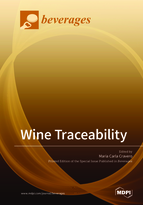Wine Traceability
A special issue of Beverages (ISSN 2306-5710).
Deadline for manuscript submissions: closed (31 December 2018) | Viewed by 40387
Special Issue Editor
Interests: grape; wine; sensorial analysis; fruit juices; consumer perception; sensorial acceptance
Special Issues, Collections and Topics in MDPI journals
Special Issue Information
Dear Colleagues,
Wine traceability is a subject extensively studied and with different facets. In the current global market, where consumers are increasingly demanding the quality and origin of food and drink, it is a central topic. Moreover, chemical wine composition can be easily falsified and all the wine production chain and its composition are strictly controlled by law (OIV, EU and national governments) and it needs specific documentation.
This Special Issue invite authors to contribute with their original studies on innovative chemical analysis or advanced methodology to certify or to assure the wine traceability along all the production steps and for the consumers.
Dr. Maria Carla CraveroGuest Editor
Manuscript Submission Information
Manuscripts should be submitted online at www.mdpi.com by registering and logging in to this website. Once you are registered, click here to go to the submission form. Manuscripts can be submitted until the deadline. All submissions that pass pre-check are peer-reviewed. Accepted papers will be published continuously in the journal (as soon as accepted) and will be listed together on the special issue website. Research articles, review articles as well as short communications are invited. For planned papers, a title and short abstract (about 100 words) can be sent to the Editorial Office for announcement on this website.
Submitted manuscripts should not have been published previously, nor be under consideration for publication elsewhere (except conference proceedings papers). All manuscripts are thoroughly refereed through a single-blind peer-review process. A guide for authors and other relevant information for submission of manuscripts is available on the Instructions for Authors page. Beverages is an international peer-reviewed open access quarterly journal published by MDPI.
Please visit the Instructions for Authors page before submitting a manuscript. The Article Processing Charge (APC) for publication in this open access journal is 1600 CHF (Swiss Francs). Submitted papers should be well formatted and use good English. Authors may use MDPI's English editing service prior to publication or during author revisions.






